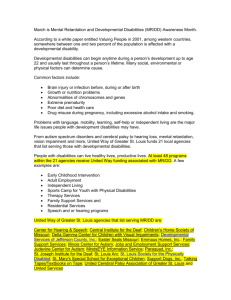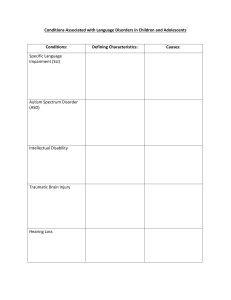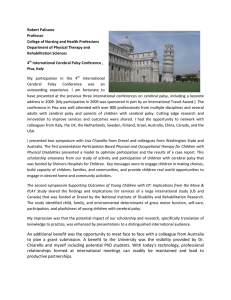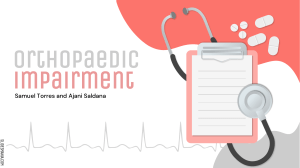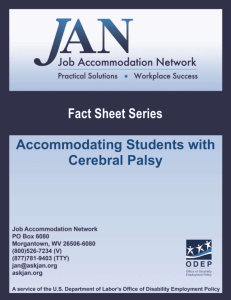Uploaded by
Marc Louis
Multiple Disabilities: Definition, Causes & Educational Support
advertisement
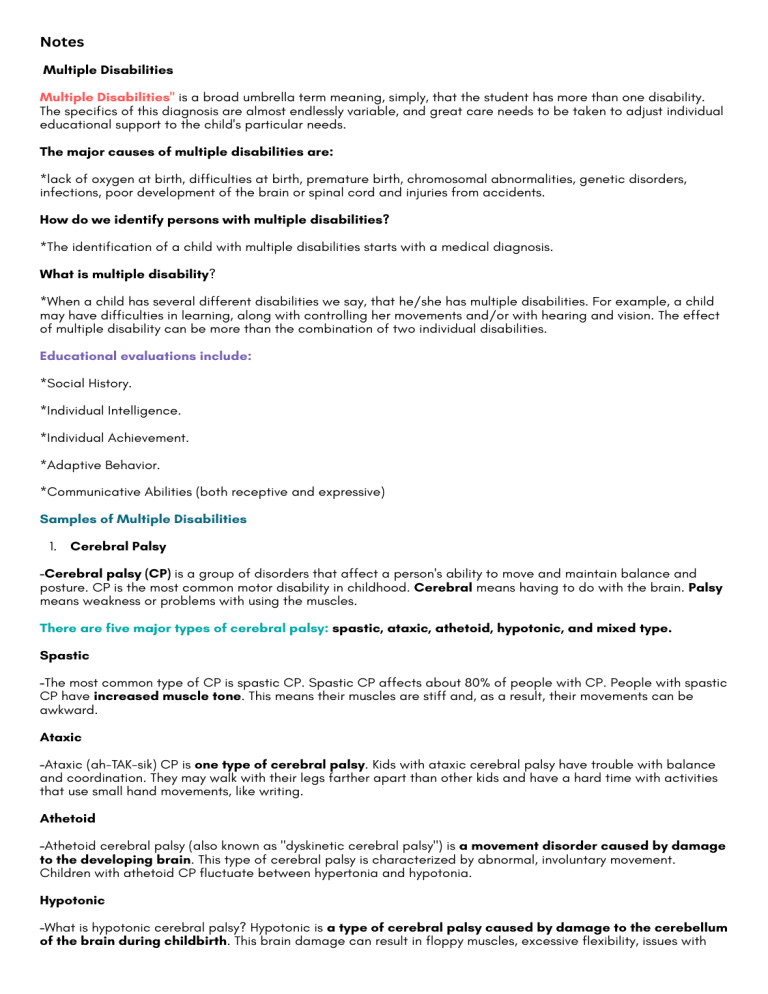
Notes Multiple Disabilities Multiple Disabilities" is a broad umbrella term meaning, simply, that the student has more than one disability. The specifics of this diagnosis are almost endlessly variable, and great care needs to be taken to adjust individual educational support to the child's particular needs. The major causes of multiple disabilities are: *lack of oxygen at birth, difficulties at birth, premature birth, chromosomal abnormalities, genetic disorders, infections, poor development of the brain or spinal cord and injuries from accidents. How do we identify persons with multiple disabilities? *The identification of a child with multiple disabilities starts with a medical diagnosis. What is multiple disability? *When a child has several different disabilities we say, that he/she has multiple disabilities. For example, a child may have difficulties in learning, along with controlling her movements and/or with hearing and vision. The effect of multiple disability can be more than the combination of two individual disabilities. Educational evaluations include: *Social History. *Individual Intelligence. *Individual Achievement. *Adaptive Behavior. *Communicative Abilities (both receptive and expressive) Samples of Multiple Disabilities 1. Cerebral Palsy -Cerebral palsy (CP) is a group of disorders that affect a person's ability to move and maintain balance and posture. CP is the most common motor disability in childhood. Cerebral means having to do with the brain. Palsy means weakness or problems with using the muscles. There are five major types of cerebral palsy: spastic, ataxic, athetoid, hypotonic, and mixed type. Spastic -The most common type of CP is spastic CP. Spastic CP affects about 80% of people with CP. People with spastic CP have increased muscle tone. This means their muscles are stiff and, as a result, their movements can be awkward. Ataxic -Ataxic (ah-TAK-sik) CP is one type of cerebral palsy. Kids with ataxic cerebral palsy have trouble with balance and coordination. They may walk with their legs farther apart than other kids and have a hard time with activities that use small hand movements, like writing. Athetoid -Athetoid cerebral palsy (also known as "dyskinetic cerebral palsy") is a movement disorder caused by damage to the developing brain. This type of cerebral palsy is characterized by abnormal, involuntary movement. Children with athetoid CP fluctuate between hypertonia and hypotonia. Hypotonic -What is hypotonic cerebral palsy? Hypotonic is a type of cerebral palsy caused by damage to the cerebellum of the brain during childbirth. This brain damage can result in floppy muscles, excessive flexibility, issues with stability, and developmental delays. Mixed type -What is mixed cerebral palsy? Mixed cerebral palsy occurs when a child exhibits symptoms of more than one type of cerebral palsy. Children diagnosed with mixed type cerebral palsy have sustained damage to the motor control centers in several parts of the brain. 2. Congenital Deafness -Congenital hearing loss (hearing loss that is present at birth) is one of the most prevalent chronic conditions in children. In the majority of developed countries, neonatal hearing screening programmes enable early detection; early intervention will prevent delays in speech and language development and has long-lasting beneficial effects on social and emotional development and quality of life. A diagnosis of hearing loss is usually followed by a search for an underlying aetiology. Congenital hearing loss might be attributed to environmental and prenatal factors, which prevail in low-income settings; congenital infections, particularly cytomegalovirus infection, are also a common risk factor for hearing loss. Genetic causes probably account for the majority of cases in developed countries; mutations can affect any component of the hearing pathway, in particular, inner ear homeostasis (endolymph production and maintenance) and mechano-electrical transduction (the conversion of a mechanical stimulus into electrochemical activity). Once the underlying cause of hearing loss is established, it might direct therapeutic decision making and guide prevention and (genetic) counselling. Management options include specific antimicrobial therapies, surgical treatment of craniofacial abnormalities and implantable or non-implantable hearing devices. An improved understanding of the pathophysiology and molecular mechanisms that underlie hearing loss and increased awareness of recent advances in genetic testing will promote the development of new treatment and screening strategies. 3. Blindness -Blindess is severe vision impairment, not correctable by standard glasses, contact lenses, medicine or surgery. It interferes with a person's ability to perform everyday activities. A person is legally blind when corrected vision in the best eye is 20/200 or less. 4. Autism -Autism is one of the most common developmental disabilities. People with autism, also called autism spectrum disorder (ASD), have differences in the way their brains develop and process information. As a result, they face significant communication, social, and behavior challenges. Symptoms can be severe and interfere with everyday tasks, or they can be mild and cause only a few problems. Experts call this range of symptoms a "spectrum." Asperger syndrome and pervasive developmental disorders (PDD) are conditions that fall within the autism spectrum. Signs of autism may include: *trouble interacting, playing with, or relating to others *little or brief eye contact with others *unusual or repetitive movements, such as hand flapping, spinning, or tapping *delays in developmental milestones or loss of already-achieved milestones *difficulties learning in school *playing with toys in ways that seem odd or repetitive *low muscle tone, clumsiness, and poor spatial awareness Although there's no cure for autism, early intervention and therapy can help kids develop skills and achieve their potential. Therapy is tailored to each child's individual needs and may include behavioral, educational, speech, and occupational therapies. Students with autism may: *get easily frustrated and act out in certain situations *be sensitive to bright lights, loud noises, or busy hallways *need to go to the school nurse for medications *miss class time for doctor visits and therapies *have trouble speaking or not speak at all seem insensitive or unemotional *need extra time for class assignments and homework *need to take tests in a separate area away from distractions Because bullies often target students who seem "different," health conditions like autism can put kids and teens at higher risk for bullying. What Teachers Can Do Many students with autism can thrive in a structured environment, so establish a routine and keep it as consistent as possible. Adhering to daily schedules and allowing ample time for transitions can help with many students' behavioral issues and frustrations. Instructional support is often needed within the classroom setting. Students with autism learn better with pictures and demonstrations. Limit long verbal instructions and provide visual cues and written instructions, when possible. Also limit distractions and use positive rewards for positive behaviors. Many people with autism have strong passions and deep interests. Getting to know your students' likes and dislikes can help you understand what motivates them. Students with autism can participate in most activities that other kids and teens do, so provide encouragement to participate when appropriate. 5. Orthopedic Impairment According to the federal Individuals With Disabilities Education Act (IDEA), an orthopedic impairment is defined as a bone-, joint-, or muscle-related disability that is so severe that it negatively affects a child’s educational performance. Causes of orthopedic impairment range from genetic abnormalities (such as those that cause a missing arm or leg) to disorders like cerebral palsy, as well as other issues. Students are typically evaluated by a healthcare professional to determine if they have an orthopedic impairment that will interfere with their academic progress. Medical professionals may also observe the child in the classroom to get a sense of potential problems the student will face. Children may be born with an orthopedic impairment or they may acquire it at some point in life.1 Hereditary, congenital, and environmental factors can play a role in causing orthopedic impairments that affect the normal functioning of the bones, joints, or muscles. For example, a child may be born with joint deformities, spina bifida, or muscular dystrophy. Acquired causes can include disease, injury, or surgery. (Injury or surgery may lead to the loss of a limb, muscle contractures, or bone loss that can make movement difficult.) The orthopedic impairment disability category, per IDEA, includes all orthopedic impairments, regardless of cause. Sometimes orthopedic impairments are called physical disabilities or included in the category of "other health impairments." Potential Causes of Orthopedic Impairment *Amputation *Birth trauma *Burns *Cerebral palsy *Disease (poliomyelitis, bone tuberculosis) *Fractures *Genetic abnormality (e.g., the absence of a member, clubfoot) *Injury



